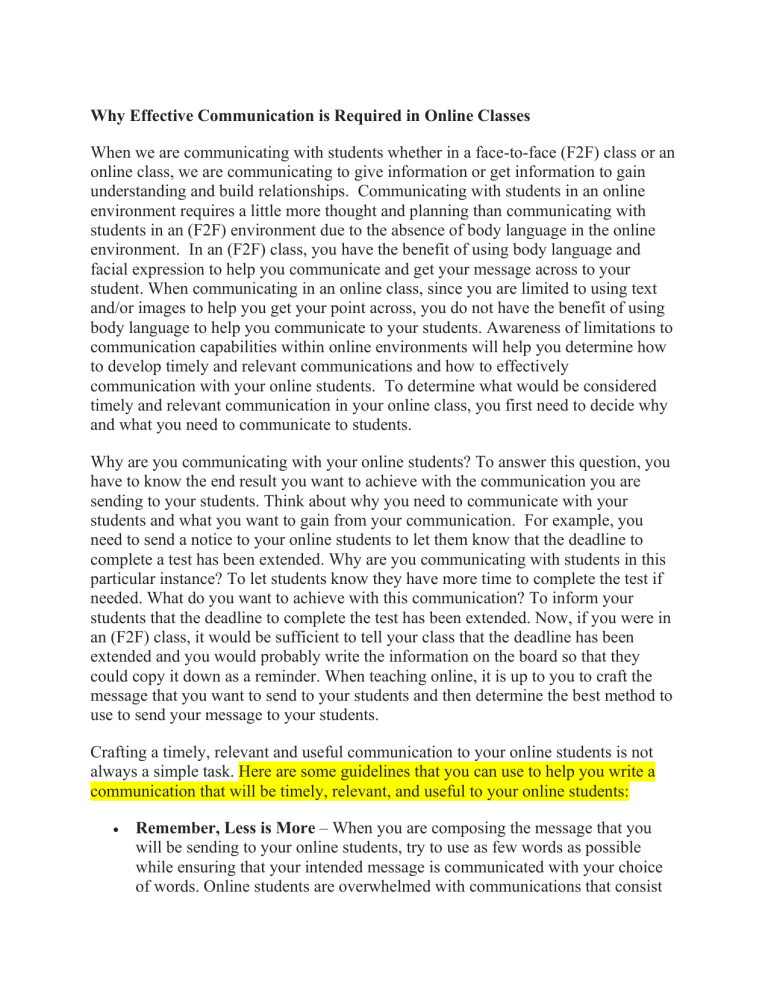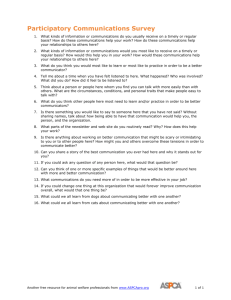
Why Effective Communication is Required in Online Classes When we are communicating with students whether in a face-to-face (F2F) class or an online class, we are communicating to give information or get information to gain understanding and build relationships. Communicating with students in an online environment requires a little more thought and planning than communicating with students in an (F2F) environment due to the absence of body language in the online environment. In an (F2F) class, you have the benefit of using body language and facial expression to help you communicate and get your message across to your student. When communicating in an online class, since you are limited to using text and/or images to help you get your point across, you do not have the benefit of using body language to help you communicate to your students. Awareness of limitations to communication capabilities within online environments will help you determine how to develop timely and relevant communications and how to effectively communication with your online students. To determine what would be considered timely and relevant communication in your online class, you first need to decide why and what you need to communicate to students. Why are you communicating with your online students? To answer this question, you have to know the end result you want to achieve with the communication you are sending to your students. Think about why you need to communicate with your students and what you want to gain from your communication. For example, you need to send a notice to your online students to let them know that the deadline to complete a test has been extended. Why are you communicating with students in this particular instance? To let students know they have more time to complete the test if needed. What do you want to achieve with this communication? To inform your students that the deadline to complete the test has been extended. Now, if you were in an (F2F) class, it would be sufficient to tell your class that the deadline has been extended and you would probably write the information on the board so that they could copy it down as a reminder. When teaching online, it is up to you to craft the message that you want to send to your students and then determine the best method to use to send your message to your students. Crafting a timely, relevant and useful communication to your online students is not always a simple task. Here are some guidelines that you can use to help you write a communication that will be timely, relevant, and useful to your online students: Remember, Less is More – When you are composing the message that you will be sending to your online students, try to use as few words as possible while ensuring that your intended message is communicated with your choice of words. Online students are overwhelmed with communications that consist of mostly text, so the last thing they want is to read a lengthy online message from their instructor. Your students are more likely to read and get the message from a concise, well-crafted communication. Be Clear – Not only should your message to your students be concise, but it also needs to be clear and leave no room for confusion on the student’s part. Using the example above, if you want to let your online students know that the deadline for the test has been extended, the message that you write to them should only talk about the extended deadline for the test. You need to make it clear by giving them all the details they need to know about the deadline extension: Know Your Audience Flahavan (2001) writes that “When communicating online, your tone will be communicated to your students through your choice of words, your sentence structure, the punctuation that you use and the order of the information that you present.“ When you are communicating with your online students it is important to remember that they may be ethnically diverse and of varying ages. These factors may affect how they perceive your communication. First, as stated before, keep your message short and to the point. Do not use acronyms or slang terms unless you are sure that everyone reading the communication will know what you are referencing. Your communications may be important to you and your students but go easy on the punctuation that you use to show this. Your students will get your message without the use of emoticons and exclamation points. Even though it is best to keep your communication brief and to the point, you will always want to give your students the opportunity to ask you additional questions if they do not understand your message. Be Courteous: Reread your communication to make sure that it sounds the way you intend it to sound. Check the tone of the communication and check for clarity and completeness of your message. Invite your students to ask questions about your message if they don’t understand it. You want your messages to be professional and let your students know that you welcome their questions.



